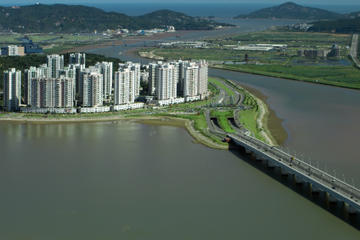
Macau Islands
One, two or three: strangely enough, all are correct answers as to how many islands are located in Macau.
Historically Macau was home to two small islands which sat just offshore of the mainland: Coloane and Taipa. With recent land reclamation efforts, however, a third island – Cotai - has managed to spring from the swamps and essentially fill in the gap which once existed between Coloane and Taipa. With the construction of Cotai, all three islands have now merged into one, leaving many to debate what exactly the real answer is.
Regardless of how many islands are actually in Macau, what’s important is that each of the three still retains their own identity and offer drastically different experiences for visitors traveling to Macau.
Coloane, the southernmost island, was historically uninhabited save for times it was used as a hideout for local pirates. Development on the island increased after the construction of the 1.3 mile (2.1 kilometer) Estrada do Istmo Causeway in 1969, but Coloane retained a laidback, rural feel; which stands in stark contrast to the fast-pace of the crowded Macau peninsula. Bisected by numerous hiking and mountain-biking trails, Coloane is also home to two of the nicest beaches in Macau: Hac Sa and Cheoc Van. After enjoying a morning jog on the beach or watching the sun rise over the ocean, head down into Coloane village for a walk among the pastel-colored Portuguese houses or to enjoy a coffee at a laidback café or bakery. Frequently referred to as a window into the “old Macau,” Coloane provides visitors a great area to stroll past dilapidated houses and find freshly caught fish hanging out to dry in the breeze.
Taipa, meanwhile, has taken the route of its more populated neighbor and exploded with residential and commercial growth. A modern city of high-rises and apartment complexes, Taipa also hosts a number of Macau’s non-gaming entertainment venues such as the Macau stadium and the Macau Jockey Club Racecourse. Nevertheless, like the neighboring city of Macau, Taipa still offers visitors a historic village pockmarked with various temples, churches and historical sites which have nothing to do with putting it all on red or black.
Finally, Cotai, the reclaimed strip of Earth responsible for joining these two islands, is exploding with the growth which has earned Macau the title of the “Las Vegas of Asia.” Impossibly glitzy and posh as can be, some of the world’s finest casinos can now be found on this former patch of muddy swampland. While familiar names such as Wynn Casino dominate the Cotai Strip, the most famous of them all is undoubtedly the Venetian Macao which currently holds the title as the world’s largest casino.
